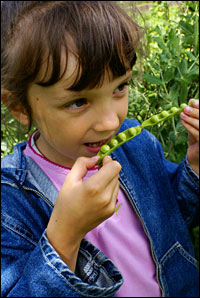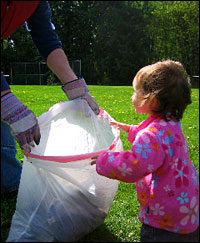
Child-rearing may be the ultimate eco-conundrum: If you have a child, you’re adding to a population that’s already burdening the planet. And as you raise that child, you may be too tired and burdened yourself to care whether all your choices are green. On the other hand, if you manage to bring up a thoughtful, conscientious kidlet whose eco-values mirror your own … well, what a gift to Gaia.
Summer may be the best time to nurture those values — or at least to have a little fun outside. From the activities you choose to the food you serve to the potions you slather on your wee ones’ skin, there’s no shortage of areas to make a difference.
So take a look at the tips and resources below for greening your family life this summer, and pick one to incorporate into your busy life today. And if you have another minute to spare, share your own ideas in our comments section.
Level One: The Baby Step
Go outside. It may seem obvious to some, but it’s overlooked by many — and it’s the simplest, most direct way to get your kids interested in the world around them. Whether you have a big backyard or have to squint past streetlights to see the stars, there’s a piece of nature waiting to be discovered. If it’s not reasonable or safe to send the kids out alone, set aside a time when you can take them to a local park, or join up with other families to plan adventures in your area. Over the past 20 years, time spent playing outdoors has shrunk by half — and over the same time, childhood obesity rates have more than doubled. A 2007 study by researchers from Indiana University and Ohio State University even showed that kids gained more weight during the summer than during the school year. Don’t let this happen to your little dumpling.
Level Two: The Next Steps
Peach your children well. Summer is the best time of year to feed your family ripe, juicy fruits and very verdant vegetables. With any luck, you have a farmers market nearby where you can buy such goodies — thereby getting the freshest produce and exposing your kids to the real world of local agriculture. But even if your farmers markets are few and farm between, your supermarket may carry locally grown items — buying them supports your local economy and reduces the impacts of shipping. Keep an eye out for organics, too — find out how to prioritize your organic spending with the list of dirty dozen fruits and vegetables. Children’s body size and metabolism mean the pesticides used in conventional agriculture can have more of an effect on them than on you, and studies have shown that kids who eat organic have lower levels of neurotoxins in their systems, even after just a few days. Yum!
Apply yourself. So you’re determined to get outside with your kids, and you want to protect them from the biting bugs and burning rays of summer. But do you know which products to use? When it comes to insect repellent, some experts say concentrations of DEET up to 30 percent appear to be safe for children, while others argue that 10 percent is the highest acceptable level; all agree that DEET shouldn’t be used on infants under two months of age. Plant-based repellents may be enough to keep the skeeters at bay — check out this rundown from Consumer Reports for details on DEET and DEET-free products and tips for application. As far as sunscreen is concerned, we’ve got another four-letter word for you: PABA. Avoid it — and check out this Smart Shoppers’ Sunblock Card for more ingredients to watch out for, as well as a list of alternative products.

Peas Mom, may I have some more?
Make your garden an eden. You know those sprays that kill the pests in your yard and garden? If they’re that good at killing critters, just think what they might be doing to your kids! Pesticides have been linked to birth defects, childhood leukemia, asthma, hyperactivity, motor dysfunction, and other ills — and research suggests that kids absorb pesticides more easily than adults, and can’t process them as well. So think twice about using them. Look into other forms of pest management, or let nature take its course. And speaking of harmful inhalations: Mamas don’t let their babies grow up to be lawn boys (or girls), at least not behind gas mowers — the pollution from those puppies is as damaging as car emissions, contributes to smog, and can exacerbate asthma.

Never too young to talk trash.
Level Three: The Big Step
Think outside the sandbox. Three cheers for you if you’re already taking some or all of the steps above. But American children will only get healthier if parents look beyond their own families and take action (it’s that whole “it takes a village” thing, remember?). It ain’t easy, but try to find time to help other families green their summers too — whether you create or join an informal family adventure network; create or join a more organized community-action group [PDF]; volunteer at a local park or nature center to help them provide opportunities for local families; rally your neighbors to help clean up trash; push for more green space in your community or more environmental education in your schools; or call your town officials when you see a truck spraying pesticides on your block. Every step counts — and every action you take gives your kids one more way to learn by example.
Resources
Encouragement and tips for getting kids outside:
Children and Nature Network
National Wildlife Federation’s Reversing Nature Deficit campaign and Green Hour program
REI Passport to Adventure program
How to find farmers markets and organic food near you: Local Harvest USDA Farmers Market directory
Environmental Working Group’s Shopper’s Guide to Pesticides in Produce
Advice on safer sunscreens and bug repellents:
A Fly in the Ointment
Consumer Reports’ Greener Choices
The Green Guide
Information on pesticides and lawn care:
Children’s Environmental Health Institute
National Coalition for Pesticide-Free Lawns
Pesticide Action Network North America
Ideas for community action:
Children & Nature Network’s Community Action Guide [PDF]
National Wildlife Federation’s Connecting Today’s Kids with Nature [PDF]
PBS Zoomteam
11th Hour Action


